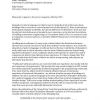Free Online Productivity Tools
i2Speak
i2Symbol
i2OCR
iTex2Img
iWeb2Print
iWeb2Shot
i2Type
iPdf2Split
iPdf2Merge
i2Bopomofo
i2Arabic
i2Style
i2Image
i2PDF
iLatex2Rtf
Sci2ools
INTERACTIONS
2010
2010
PUX: patterns of user experience
s from a concrete to a new abstract level of description [1]. Rises in abstraction level happen regularly in all fields, but the key difference in Alexander's work was that ract descriptions were founded in user experience, not in abstract descriptions of building construction (engineering) or of ornament (style). This is in contrast to recent developments in software patterns, as noted by Molly Steenson in her recent Interactions article[2]. In talking about software, it is easy to get confused about the distinctions between and concrete, because so much about software seems abstract. As a result, the adaptation of pattern languages to software has lost the key contribution of Alexander's work, which was to throw attention onto the users. Software patterns, despite being by Alexander's work, emphasise abstract descriptions of construction and of , not abstract descriptions of user experience. It's time to change that. This article tracks down the history of where w...
| Added | 05 Mar 2011 |
| Updated | 05 Mar 2011 |
| Type | Journal |
| Year | 2010 |
| Where | INTERACTIONS |
| Authors | Alan F. Blackwell, Sally Fincher |
Comments (0)

